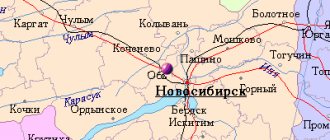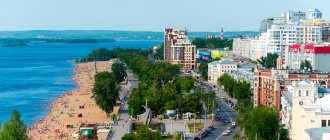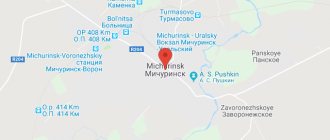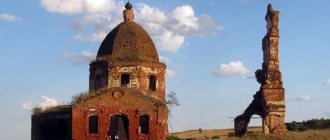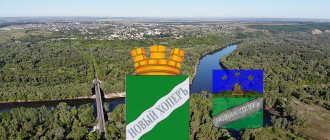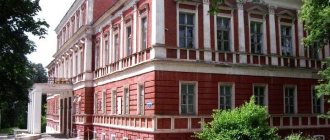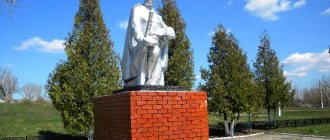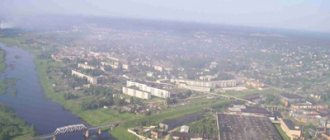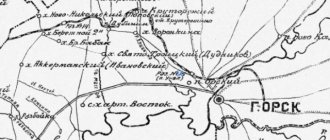Kuibyshev
(Novosibirsk region)
OKATO code:
50415
Founded:
1772
City since:
1782 City of district subordination (Kuibyshevsky district of the Novosibirsk region)
Center:
Kuibyshevsky district
The city was formerly called:
| Kainsk | 1782 | 1935 |
| Telephone code (reference phone) | |
| 38362***** | 21-2-30 |
Deviation from Moscow time, hours:
4
Geographical latitude:
55°27′
Geographical longitude:
78°18′
Altitude above sea level, meters:
110 Sunrise and sunset times in the city of Kuibyshev
Great Panic of October 1941
0
Under the circumstances, this decision was quite logical. However, the beginning of its implementation provoked the famous “Moscow Panic of October 1941.” The first to rush to implement the decree were officials who tried to evacuate not only state property, but also personal property. The sight of the cars in which the party and state nomenklatura tried to escape to the east made a depressing impression on Muscovites. Leaving managers sometimes left neither responsible persons nor instructions on further actions. At the enterprises, workers were sent home, given a month's salary in advance. October 16, 1941 became the first and so far only day in history when the Moscow Metro stopped operating. It was being prepared for destruction if the city was occupied by the Germans. Other transport also worked intermittently.
0
Looking at the actions of the authorities, ordinary citizens also collected their belongings and fled from the city. The Ryazanskoye Highway and the Enthusiasts Highway were clogged with people and cars. It was almost impossible to get on trains and trains. Robberies have become more frequent on the streets. They attacked cars carrying property being taken out and stole food from stores. Some enterprise managers, taking advantage of the situation, tried to disappear with government money. Moscow was filled with rumors. In the absence of official information, someone said that German tanks were either in Odintsovo or already in the area of the Belorussky railway station. There were those who were preparing to greet the Nazis as “liberators.” It was possible to stop the panic only after the introduction of a state of siege in Moscow on October 20, 1941. The document, in particular, ordered that “violators of order should be immediately brought to justice and handed over to a military tribunal, and provocateurs, spies and other agents of the enemy calling for a violation of order should be shot on the spot.”
Map
| Kuibyshev: maps |
Kuibyshev: photo from space (Google Maps) Kuibyshev: photo from space (Microsoft Virtual Earth)
| Kuibyshev. Nearest cities. Distances in km. on the map (in brackets along roads) + direction. Using the hyperlink in the distance , you can get the route (information courtesy of the AutoTransInfo website) | |||
| 1 | Barabinsk | 11 (10) | YU |
| 2 | Zdvinsk | 86 (96) | YU |
| 3 | Ubinskoe | 89 (102) | IN |
| 4 | Vats | 98 (173) | Z |
| 5 | Northern | 99 () | WITH |
| 6 | Vengerovo | 100 (125) | Z |
| 7 | Kargath | 128 (150) | IN |
| 8 | Chistoozernoe | 136 (242) | SW |
| 9 | Kupino | 136 (313) | SW |
| 10 | Satisfied | 137 (253) | SE |
| 11 | Tatarsk | 149 (162) | Z |
| 12 | Bagan | 155 (351) | YU |
| 13 | Kyshtovka | 161 (238) | NW |
| 14 | Ust-Tarka | 164 (193) | Z |
a brief description of
Located on the Barabinskaya lowland, on the banks of the river. Om (tributary of the Irtysh), 315 km west of Novosibirsk.
Railway station, road junction.
Kuibyshev is a developed industrial center of the Baraba Lowland, which is facilitated by its location on the Om River and its connection with the Trans-Siberian Railway. highway.
Territory (sq. km): 110
Information about the city of Kuibyshev on the Russian Wikipedia site
Historical sketch
Founded in 1722 as a military fortification of Kainsky Pass to protect the Baraba residents from the Kalmyks and Kyrgyz. The settlement of Kain, which arose near the fortification (kain translated from Tatar means “birch”), was moved to the site of the current city in 1772.
Since 1782, the district town of Kainsk, Tomsk region, Tobolsk governorship (since 1796 - Tobolsk province). Since 1804 - a district town of the Tomsk province. Located on the Siberian Highway, it was a busy trading post.
In 1856, in the district town of Kainsk, Tomsk province, there were 2 churches, 383 houses, 28 shops.
With the construction of the Trans-Siberian Railway, which ran 13 km to the south, the importance of Kainsk dropped noticeably. At the end of the 19th century. in Kainsk there were 5 stone and about 900 wooden houses, there was a women's gymnasium and a parish school.
In 1935, Kainsk was renamed in honor of the revolutionary figure V.V. Kuibyshev (1888-1935), who in 1907-09. was here in exile.
Municipal indicators
| Index | 2001 |
| Demography | |
| Number of births, per 1000 population | 8.9 |
| Number of deaths, per 1000 population | 13.1 |
| Natural increase (decrease), per 1000 population | -4.2 |
| Standard of living of the population and social sphere | |
| Average monthly nominal accrued wages, rub. | 1765.5 |
| Average housing area per inhabitant (at the end of the year), sq.m. | 23.9 |
| Number of preschool institutions, pcs. | 14 |
| Number of children in preschool institutions, thousand people | 1.754 |
| Number of daytime educational institutions (at the beginning of the school year), pcs. | 14 |
| Number of students in daytime educational institutions, thousand people | 6.394 |
| Number of doctors, people. | 208 |
| Number of nursing staff, people. | 747 |
| Number of hospital institutions, pcs. | 6 |
| Number of hospital beds, thousand units | 0.845 |
| Number of medical outpatient clinics, pcs. | 8 |
| Capacity of medical outpatient clinics, visits per shift, thousand units. | 0.803 |
| Economy, industry | |
| Number of enterprises and organizations (at the end of the year), pcs. | 2210 |
| Construction | |
| Volume of work performed by type of activity “Construction” (until 2004 - volume of work performed under construction contracts), million rubles. | 59.5 |
| Commissioning of residential buildings, thousand sq.m. of total area | 10.4 |
| Commissioning of residential buildings, apartments | 155 |
| Commissioning of preschool institutions, places | 0 |
| Commissioning of educational institutions, places | 0 |
| Commissioning of hospital facilities, beds | 0 |
| Commissioning of outpatient clinics, visits per shift | 0 |
| Transport | |
| Number of bus routes (in intracity traffic), pcs. | 11 |
| Number of passengers transported by buses per year (in intracity traffic), million people. | 10.976 |
| Connection | |
| Number of residential telephone sets of the city public telephone network, thousand units. | 7.4 |
| Trade and services to the population | |
| Retail trade turnover (in actual prices), million rubles. | 686.3 |
| Retail trade turnover (in actual prices), per capita, rub. | 13576.8 |
| Public catering turnover (in actual prices), million rubles. | 22.6 |
| Volume of paid services to the population (in actual prices), million rubles. | 135.7 |
| Volume of paid services to the population (in actual prices), per capita, rub. | 2484 |
| Volume of household services to the population (in actual prices), million rubles. | 20.4 |
| Volume of household services to the population (in actual prices), per capita, rub. | 373 |
| Investments | |
| Investments in fixed assets (in actual prices), million rubles. | 43.1 |
| Share of investments in fixed assets financed from budgetary funds in the total volume of investments, % | 40.7 |
Data sources:
- Regions of Russia. Main characteristics of the constituent entities of the Russian Federation: statistical collection. Goskomstat of Russia. - M:, 2003.
Economy
Factories: chemical, aircraft parts, reinforced concrete products and structures. Combines: milk-canning and meat. Factories: clothing and art products.
Barabinskaya GRES.
In the Kuibyshev region, wheat, rye, barley, oats, corn, sunflower, rapeseed, and camelina are grown. Meat and dairy farming.
Clay deposit.
Main enterprises
CHEMICAL INDUSTRY
FSUE "Kuibyshev Chemical Plant"
632350, Novosibirsk region, Kuibyshevsky district, Kuibyshev, st.
Sadovaya, 3 Offers:
hydrogen peroxide, ammonium chloride, household chemicals, synthetic detergents
LIQUOR AND VODKA INDUSTRY
JSC "KAOLVI"
632350, Novosibirsk region, Kuibyshevsky district, Kuibyshev, st.
Shishkova, 2 Offers:
Vodka, liquor, mineral water, soft drinks
Culture, science, education
Branch of Novosibirsk Pedagogical University.
Museum of Local Lore and House-Museum of V.V. Kuibysheva.
Universities of the city
Kuibyshev branch of the Novosibirsk State Pedagogical University
632387, Novosibirsk region, Kuibyshevsky district, Kuibyshev, st. Molodezhnaya, 7
Kuibyshev branch of Novosibirsk State Technical University
632386, Novosibirsk region, Kuibyshevsky district, Kuibyshev, Kainskaya st., 78
Museums, galleries, exhibition halls
State Memorial House-Museum of V.V. Kuibyshev 632350, Novosibirsk region, Kuibyshevsky district, Kuibyshev, st.
Lenina, 2 Kuibyshev Museum of Local Lore 632380, Novosibirsk region, Kuibyshevsky district, Kuibyshev, st. Kuibysheva, 10
Architecture, sights
Church of John the Baptist (1906), former house of Volkov (1884), etc.
| Population by year (thousands of inhabitants) | |||||||
| 1856 | 2.7 | 1986 | 50 | 2005 | 48.5 | 2014 | 44.5 |
| 1897 | 5.9 | 1989 | 51.2 | 2006 | 48.5 | 2015 | 44.6 |
| 1931 | 9.2 | 1992 | 51.6 | 2007 | 48.2 | 2016 | 44.6 |
| 1939 | 12.9 | 1996 | 51.8 | 2008 | 48.0 | 2017 | 44.2 |
| 1959 | 30.4 | 1998 | 51.7 | 2010 | 47.3 | 2018 | 44.2 |
| 1967 | 40 | 2000 | 51.3 | 2011 | 45.3 | 2019 | 43.8 |
| 1970 | 40.2 | 2001 | 50.7 | 2012 | 44.8 | 2020 | 43.5 |
| 1979 | 46.5 | 2003 | 48.8 | 2013 | 44.6 | 2021 | 43.2 |
“Due to the unfavorable situation”
0
See all photos in the gallery
By mid-October 1941, the situation in the Moscow direction of the Soviet-German front became critical. The offensive of the main forces of the German Army Group Center led to the encirclement of a group of Soviet troops near Vyazma. The immediate approaches to the capital were not covered by a sufficient number of troops. The threat of the fall of the capital of the USSR became more than real. On October 12, 1941, Kaluga fell. German units reached the lines located 150-200 kilometers from Moscow.
0
On October 15, the State Defense Committee of the USSR adopted Resolution No. 801 “On the evacuation of the capital of the USSR Moscow”: “In view of the unfavorable situation in the area of the Mozhaisk defensive line, the State Defense Committee decided: 1. Instruct Comrade Molotov to inform foreign missions that they evacuate to the city today. Kuibyshev (NKPS - Comrade Kaganovich ensures the timely supply of trains for missions, and the NKVD - Comrade Beria organizes their protection.) 2. Today evacuate the Presidium of the Supreme Council, as well as the Government headed by the Deputy Chairman of the Council of People's Commissars, Comrade Molotov (Comrade Stalin evacuated tomorrow or later, depending on the situation). 3. Immediately evacuate the People's Commissariat of Defense to the city of Kuibyshev, and the main group of the General Staff to Arzamas. 4. In the event of enemy troops appearing at the gates of Moscow, instruct the NKVD - Comrade Beria and Comrade Shcherbakov to blow up enterprises, warehouses and institutions that cannot be evacuated, as well as all electrical equipment of the metro (excluding water supply and sewerage). Chairman of the State Defense Committee of the USSR I. STALIN"
×
Leader's headquarters at a depth of 37 meters
0
Not all structures were able to be located in Kuibyshev. The General Staff, as stated in the GKO Resolution, was located in Arzamas. At the same time, the General Staff operational group led by Alexander Vasilevsky continued to work in Moscow. Similar groups were created in other people's commissariats, so complete desolation did not reign in Moscow after the departure of government structures. The question of evacuating the head of state hung in the air. There were at least a dozen options for removing Joseph Stalin, including the use of a car, train or plane. According to one version, the Soviet leader even came to the station where the train was waiting for him, but after wandering around the platform for some time, Stalin decided not to leave Moscow.
0
Preparations for the leader's move, however, continued. On October 21, 1941, the State Defense Committee issued secret decree No. 826ss “On the construction of a shelter in the city of Kuibyshev.” In February 1942, construction began on a bunker under the building of the Kuibyshev Regional Committee. At a depth of 37 meters, an object was created that was to become the reserve headquarters of the Supreme Commander-in-Chief.
0
Moscow metro workers and Donbass miners worked on the construction of the facility, from whom a non-disclosure agreement was taken without a statute of limitations.
0
Work was carried out around the clock, in two shifts. In less than a year, 25 thousand cubic meters of soil were removed and 5 thousand cubic meters of concrete were laid. On January 6, 1943, the facility was officially accepted into operation.
0
The one for whom the underground shelter was intended never visited it: the situation changed in favor of the Soviet Union.
0
The object was declassified only in the last years of Soviet power, in 1990. Today "Stalin's Bunker" has become a museum.
Speaker Levitan's secret
0
Not only employees of the People's Commissariats and diplomatic missions moved to Kuibyshev. The Bolshoi Theater also moved here and began operating in a new location in December 1941. At the same time, performances continued in Moscow, where a branch of the troupe remained. It is curious that performances in the “branch” were resumed earlier: on November 14, 1941. The Union of Composers was created in Kuibyshev, performing competitions, chamber and author concerts were held. Artistic front-line brigades were also formed here.
0
In the summer of 1941, construction began in Kuibyshev of “object 15,” the most powerful radio station in the world. Its trial broadcasts began in September 1942. Since March 1943, announcer Yuri Levitan began reading Sovinformburo reports from Kuibyshev. Until this moment, Levitan proclaimed on the air “Moscow speaking!” from Sverdlovsk, where he worked since the autumn of 1941. The information that the main announcer was broadcasting from outside Moscow remained secret for another quarter of a century.
0
In the fall of 1941, composer Dmitry Shostakovich was taken to Kuibyshev from besieged Leningrad. In the “reserve capital” he completed his Seventh “Leningrad” Symphony. The seventh symphony was first performed at the Kuibyshev Opera and Ballet Theater on March 5, 1942 by the Bolshoi Theater Orchestra of the USSR under the direction of conductor Samuil Samosud.
"Headquarters" in the library
According to the chief bibliographer of the SUNB, Alexander Zavalny, at first all the initiators of renaming the city acted separately. However, in February 1989, 12 activists gathered in the political book library and decided to establish the Samara public committee. It included priest John, Archbishop of Kuibyshev and Syzran. The writer Andrei Pavlov, who gained the authority of local historians after the publication of the book “Reserve Capital,” was elected chairman.
The library of political books became a kind of committee headquarters. A barn notebook was placed right at the entrance. On its pages, everyone could express their opinion on the issue of renaming Kuibyshev. There were many indignant reviews. Sometimes people burst into the library, waved their fists, called names, shouted: “You are against the Soviet regime!” However, there were more supporters of the idea. The grandson of the sculptor Vladimir Sherwood, the author of the monument to Alexander II that was demolished during the revolution, came here specially to support the initiative. And even old party members who knew Kuibyshev personally said that he himself would be against giving the ancient city his name. The future governor, at that time chairman of the city executive committee of the Council of People's Deputies, Konstantin Titov, left an interesting note: “Don’t we have other problems? We can make a huge list of what needs to be decided, approved and done in Kuibyshev, and not distract people from the necessary work and spend huge amounts of money, but use it for the needs of the city: installing telephones, accelerating the construction of the metro, keeping the city clean, etc.” .
Now, assessing all the pros and cons of returning the city’s historical name, Konstantin Titov notes that in reality the costs of renaming were not so great. But since he ran from the working-class Bezymyanka, voters ordered him not to support a harmful initiative under any circumstances.
— Almost all of the representatives of my home team, the aviation plant, were evacuated from Voronezh during the war. They said: we were going to work in Kuibyshev, and we will live in Kuibyshev,” says Konstantin Alekseevich.
Message from members of the Samara Public Committee:
“To the Supreme Soviet of the USSR. We believe that the city of SAMARA was renamed in 1935 in an undemocratic way, without taking into account the opinions of the majority of residents. This act lost the historical name of the glorious and heroic city where Lenin began his journey into the revolution. We ask the Supreme Council to restore the original name of the city and consider historical names as monuments of the history and culture of the people. Samara is on the map of Russia.”
How the idea of renaming was born
The first of my interlocutors was Doctor of Historical Sciences, Professor Pyotr Kabytov. It was he who was the author of the initiative that caused a stir. Pyotr Serafimovich is not a native Samarian. However, his contribution to the study of the history of our region cannot be overestimated. In the 1970s, Kabytov was invited as a teacher at the newly opened state university. The young scientist turned to local archives. And I found out how interesting information they contain about pre-revolutionary Samara. At that time, perhaps, only Professor Kuzma Nayakshin systematically studied the history of the Middle Volga region. But he presented the information in his works from the point of view of Marxist ideology. Many sources spoke about old Samara in a derogatory tone: they say, “a cultureless, dusty city in which there are many more churches than schools.” I remembered these words from the text of the tour of the Lenin House Museum. Pyotr Kabytov, getting acquainted with archival documents, felt the injustice of such statements. He recalls the events of the late 80s:
— General Secretary of the CPSU Central Committee Gorbachev was concerned that his wife did not have a social burden. The Soviet Cultural Foundation was created, where she became the main trustee. The regions received an order to organize local branches. I received a call from the White House and, as the chairman of the regional society for the protection of cultural monuments, was invited to a meeting. It took place at the Actor's House, and a huge number of people came to the meeting. The Writers' Union, artists already united in a guild, architects and other creative intelligentsia. The then head of the regional department of culture, Boris Ivanovich Sharkunov, spoke with a call to support and organize. Then came the speeches of the leaders of creative associations. They were essentially just reports of achievements. No fresh thoughts or initiatives.
Pyotr Serafimovich sat in the back rows and thought about how to stir up this meeting. And when he was called to the podium, he made a long-held proposal: “I think we all need to start by returning the name to the regional center. Do you remember what our city was called? Samara! It was in Samara that Lenin began his revolutionary activities. And Kuibyshev, I believe, will not be offended by us if we return the city to its historical name!”
The hall met these words with silence. Then there were shouts: “You’re aiming at something sacred!”
Suburbs are growing faster than cities
In the period between the 2002 and 2010 censuses, when the population of the Novosibirsk region fell by 1%, the following territorial and demographic processes can be safely identified:
1. The Novosibirsk agglomeration is taking shape in the region, determined both by the formation of a zone of continuous development of populated areas and by existing communications. The agglomeration extends from its core in petals in six directions, coinciding with highways (Horda and Kolyvan directions) or with highways and railways (western, eastern, Kuznetsk, southern directions).
2. In the Novosibirsk region, suburbanization is beginning to clearly manifest itself, when the population of suburbs (both satellite cities and rural areas) is growing faster than the population of urban cores. In the case of the Novosibirsk agglomeration, it looks like this: Novosibirsk, Ob, Krasnoobsk and most village councils of the Novosibirsk region - up to +10%, Berdsk, Tolmachevo, Krivodanovka, Kamenka, Kudryashi, Novolugovoe and Barlak - +10+25%, Mochishche and Koltsovo - up to +30%, and the population of Razdolnensky and Michurinsky village councils of the Novosibirsk region has grown by 60% over these eight years.
In the Kuibyshev-Barabinsk agglomeration the situation turned out to be even more interesting. While the population of both cities fell by 6–7%, the number of residents of some suburban village councils increased by 2–3%. A similar phenomenon can be seen in the Karasuk region.
3. Outside the Novosibirsk agglomeration, almost the entire territory of the region is experiencing significant depopulation and migration outflow. But unlike the previous period, the rate of population decline is higher in rural areas. In the vast majority of regions, the rate of population decline in village councils remote from regional centers and highways is on average three times higher than in regional centers.
4. The highest rate of population decline is in the Vasyugan zone, where all village councils in the north of the Kolyvan, Chulym and Ubinsk regions lost during this period from a quarter to a half of the population that had already decreased in the 90s. And the north of the Kyshtovsky district - even more than half of all people. The only exception is the North, where investments related to oil production date back to this period.
In the Barabinskaya zone and the Kulundinskaya zones, a very clear division is emerging - all regional centers have steadily lost up to 10% of the population, most of the rural areas - up to a quarter of the population, and municipalities remote from the highways - sometimes up to half in just this less than a decade. However, in general, the scale of the decline in the rural population in Baraba for each group of municipalities is on average approximately 1.5 times higher than in Kulunda.
